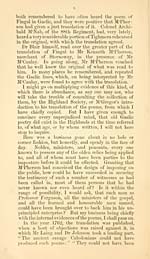Download files
Complete book:
Individual page:
Thumbnail gallery: Grid view | List view

orally transmitted through so many barbarous ages;"
" Fingal was a myth, Ossian was a myth, M'Fherson
was an impostor, the Enghsh nation had been grossly
imposed on."
I will not attempt to follow the discussion raised
on these objections, I will simply take the objections
themselves, and see whether they are relevant. The
charge of savageness, as applied to the ancient Cale-
donians, has, in my opinion, been carried too far.
The term, in its modern signification at least, seems to
convey the idea of a people ignorant of the mechanical
arts, and destitute of the comforts their possession se-
cures. In ow, let us see what incontrovertible facts testify,
as to the condition of the Caledonians in this respect.
The large and massive remains of stone forts and
other buildings, of a pre-historic period, to be foun I
scattered over the face of the country, show that they
were not ignorant of masonry. " So huge," says
Chambers in his Caledonia, " are the stones in many
of these hill forts, the ingenious construction of many
hands, that they could not, even now, be taken by
storm, and it was impossible that they could have
besn set in their present position without the aid of
machinery, had the ancient Caledonians thrice the
strength of their descendants." Of these forts,
several are to be seen in Glenlyon, and along the
valley of the Tay. On the estate of Pitcastle, in
Strathtciy, the ruins of one are to be seen, and those
of another, on the estate of TuUipourie adjoining, both
traditionally designated Caisteal duhh, (black castle.)
Another, bearing the same designation, but of much
larger dimensions, stands on a spur of the hill above
Gi-andtully. This latter, from its very commanding
position, extent, and strength of walls, must have
been very formidable. On an eminence on the low
grounds of TuUipourie, there is to be seen an immense
circular excavation, the formÌTig of which, must have
taken a great amount of labour, such as savages
would never have undertaken, even had they possessed
the requisite tools for it. It is called " an daùjh-
ueach," (the stronghold,) a burn passing close by is
called ^^ aid a bhlcu^ " (the battle burn), while a field
adjoining is called " dal a bhlar" (the battle field,)
thus indicating that the besieged, probably pressed by
want of provisions, had made a sortie on the besiegers,
when a general engagement took place.
" Fingal was a myth, Ossian was a myth, M'Fherson
was an impostor, the Enghsh nation had been grossly
imposed on."
I will not attempt to follow the discussion raised
on these objections, I will simply take the objections
themselves, and see whether they are relevant. The
charge of savageness, as applied to the ancient Cale-
donians, has, in my opinion, been carried too far.
The term, in its modern signification at least, seems to
convey the idea of a people ignorant of the mechanical
arts, and destitute of the comforts their possession se-
cures. In ow, let us see what incontrovertible facts testify,
as to the condition of the Caledonians in this respect.
The large and massive remains of stone forts and
other buildings, of a pre-historic period, to be foun I
scattered over the face of the country, show that they
were not ignorant of masonry. " So huge," says
Chambers in his Caledonia, " are the stones in many
of these hill forts, the ingenious construction of many
hands, that they could not, even now, be taken by
storm, and it was impossible that they could have
besn set in their present position without the aid of
machinery, had the ancient Caledonians thrice the
strength of their descendants." Of these forts,
several are to be seen in Glenlyon, and along the
valley of the Tay. On the estate of Pitcastle, in
Strathtciy, the ruins of one are to be seen, and those
of another, on the estate of TuUipourie adjoining, both
traditionally designated Caisteal duhh, (black castle.)
Another, bearing the same designation, but of much
larger dimensions, stands on a spur of the hill above
Gi-andtully. This latter, from its very commanding
position, extent, and strength of walls, must have
been very formidable. On an eminence on the low
grounds of TuUipourie, there is to be seen an immense
circular excavation, the formÌTig of which, must have
taken a great amount of labour, such as savages
would never have undertaken, even had they possessed
the requisite tools for it. It is called " an daùjh-
ueach," (the stronghold,) a burn passing close by is
called ^^ aid a bhlcu^ " (the battle burn), while a field
adjoining is called " dal a bhlar" (the battle field,)
thus indicating that the besieged, probably pressed by
want of provisions, had made a sortie on the besiegers,
when a general engagement took place.
Set display mode to: Large image | Transcription
Images and transcriptions on this page, including medium image downloads, may be used under the Creative Commons Attribution 4.0 International Licence unless otherwise stated. ![]()
| Early Gaelic Book Collections > Ossian Collection > Authenticity of the poems of Ossian > (9) |
|---|
| Permanent URL | https://digital.nls.uk/78396498 |
|---|
| Description | Selected books from the Ossian Collection of 327 volumes, originally assembled by J. Norman Methven of Perth. Different editions and translations of James MacPherson's epic poem 'Ossian', some with a map of the 'Kingdom of Connor'. Also secondary material relating to Ossianic poetry and the Ossian controversy. |
|---|
| Description | Selected items from five 'Special and Named Printed Collections'. Includes books in Gaelic and other Celtic languages, works about the Gaels, their languages, literature, culture and history. |
|---|

